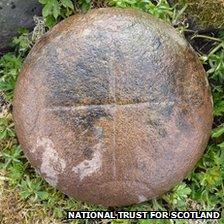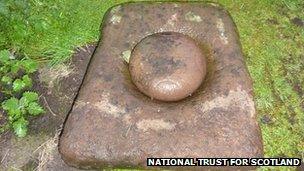'Cursing stone' found on Isle of Canna
- Published

The bullaun stone was found in an old graveyard
A stone discovered by chance on the Isle of Canna is Scotland's first known example of a bullaun "cursing stone", experts have revealed.
Dating from about 800 AD, the stones are associated with early Christian crosses - of which there is one on the isle.
It was found in an old graveyard by a National Trust for Scotland (NTS) farm manager.
The stone is about 25cm in diameter and engraved with an early Christian cross.
It was later found to fit exactly into a large rectangular stone with a worn hole which was located at the base of the Canna cross.
NTS manager of Canna, Stewart Connor, said the importance of the stone became clear after he was notified of the discovery.
He said: "We knew of the importance of bullaun stones and that it could be a really significant find.
"Our head of archaeology confirmed a possible link to the stone at the cross and I was so excited that I went back out at 9pm that night to check whether it fitted the stone with the hole and it did."
'Cursing stones'
Katherine Forsyth, an expert in the history and culture of early Celtic-speaking peoples, based at the University of Glasgow, described it as an "amazing find".
"Stones like this are found in Ireland, where they are known as 'cursing stones', but this is the first to be discovered in Scotland," she said.

This is the first time a top stone has been discovered
"They date from the early Christian period but have continued to be used by pilgrims up to modern times.
"Traditionally, the pilgrim would recite a prayer while turning the stone clockwise, wearing a depression or hole in the stone underneath."
Dr Forsyth said bowl-shaped lower stones had been found elsewhere in Scotland, including on Canna, but this was the first discovery of a top stone.
She added: "This exciting find provides important new insight into religious art and practice in early Scotland and demonstrates just how much there is still to be discovered out there."
In the early-Christian period, Canna belonged to the monastery on Iona.
The island was gifted to the National Trust for Scotland in 1981 by Gaelic scholar John Lorne Campbell.